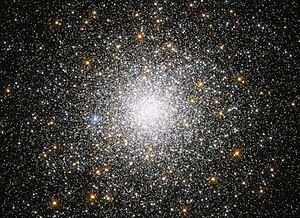Messier 75
| Messier 75 | |
|---|---|
 | |
| Observation data (J2000 epoch) | |
| Class | I[1] |
| Constellation | Sagittarius |
| Right ascension | 20h 06m 04.85s[2] |
| Declination | −21° 55′ 17.85″[2] |
| Distance | 68 kly (20.9 kpc)[3] |
| Apparent magnitude (V) | 8.5[4] |
| Apparent dimensions (V) | 6.8′ |
| Physical characteristics | |
| Absolute magnitude | −8.57[2] |
| Radius | 67 ly[5] |
| Tidal radius | 5.7′[3] |
| Metallicity | = −1.29[6] dex |
| Other designations | GCl 116, M75, NGC 6864[7] |
Messier 75 or M75, also known as NGC 6864, is a giant globular cluster of stars in the southern constellation Sagittarius.[a] It was discovered by Pierre Méchain in 1780 and included in Charles Messier's catalog of comet-like objects that same year.[8]
M75 is about 67,500[3] light years away from Earth and is 14,700[6] light years away from, and on the opposite side of, the Galactic Center.[9] Its apparent size on the sky translates to a true radius of 67 light years.[5] M75 is classified as class I, meaning it is one of the more densely concentrated globular clusters known. It shows a slow rotation around an axis that is inclined along a position angle of −15°±30°.[3] The absolute magnitude of M75 is about −8.5, equating to 180,000 times more luminous than the Sun (L☉).[8]
The cluster has a half-light radius of 9.1 ly (2.80 pc)[6] with a core radius of about 1.6 ly (0.5 pc) and appears not to have undergone core collapse yet. The mass density at the core is 7.9×104 M☉·pc−3.[b][2] There are 38 RR Lyrae variable stars and the cluster appears to be Oosterhoff-intermediate in terms of metallicity.[9] 62 candidate blue stragglers have been identified in the cluster field, with 60% being in the core region.[2]
Messier 75 is part of the Gaia Sausage, the hypothesized remains of a dwarf galaxy that merged with the Milky Way.[10] It is a halo object with an orbital period of 0.4 billion years to travel around the galaxy on a very pronounced ellipse, specifically eccentricity of 0.87. The apocenter (maximal distance from Earth) is about 57,000 ly (17,500 pc).[3]
Gallery
[edit]-
Messier 75 - wide field view
-
Map showing location of M75
See also
[edit]References and footnotes
[edit]- ^ Shapley, Harlow; Sawyer, Helen B. (August 1927), "A Classification of Globular Clusters", Harvard College Observatory Bulletin, 849 (849): 11–14, Bibcode:1927BHarO.849...11S.
- ^ a b c d e Contreras Ramos, R.; et al. (April 2012), "The Unimodal Distribution of Blue Straggler Stars in M75 (NGC 6864)", The Astrophysical Journal, 748 (2): 9, arXiv:1201.4959, Bibcode:2012ApJ...748...91C, doi:10.1088/0004-637X/748/2/91, S2CID 118483222, 91.
- ^ a b c d e Koch, Andreas; et al. (August 2018), "Kinematics of outer halo globular clusters: M 75 and NGC 6426", Astronomy & Astrophysics, 616: 9, arXiv:1805.06894, Bibcode:2018A&A...616A..74K, doi:10.1051/0004-6361/201833110, S2CID 119430366, A74.
- ^ "Messier 75". SEDS Messier Catalog. Retrieved 30 April 2022.
- ^ a b From trigonometry: radius = distance × sin( diameter_angle / 2 ) = 67 ly.
- ^ a b c van den Bergh, Sidney (February 2012), "Sizes of Galactic Globular Clusters", The Astrophysical Journal, 746 (2): 4, arXiv:1201.3597, Bibcode:2012ApJ...746..189V, doi:10.1088/0004-637X/746/2/189, S2CID 250796835, 189.
- ^ "NGC 6864". SIMBAD. Centre de données astronomiques de Strasbourg. Retrieved 16 November 2006.
- ^ a b Frommert, Hartmut; Kronberg, Christine (2 September 2007), "Messier 75", SEDS Messier pages, Students for the Exploration and Development of Space (SEDS), retrieved 5 December 2018.
- ^ a b Corwin, T. M.; et al. (May 2003), "M75, A Globular Cluster with a Trimodal Horizontal Branch. II. BV photometry of the RR Lyrae Variables", The Astronomical Journal, 125 (5): 2543–2558, arXiv:astro-ph/0301542, Bibcode:2003AJ....125.2543C, doi:10.1086/374232, S2CID 14043060.
- ^ C., Myeong, G.; et al. (August 2018), "The Sausage Globular Clusters", The Astrophysical Journal Letters, 863 (2): 5, arXiv:1805.00453, Bibcode:2018ApJ...863L..28M, doi:10.3847/2041-8213/aad7f7, S2CID 67791285, L28.
{{citation}}: CS1 maint: multiple names: authors list (link)
- ^ In a mildly south part of this zone of the sky, +90 declination would give a zenith above the north pole, whereas minus 22 degrees (rounded) precludes it from rising therefore (being above the horizon) at the 68th parallel north and hampers visibility at lower latitudes nearby
- ^ meaning: per cubic parsec
External links
[edit]- Messier 75, Galactic Globular Clusters Database page
- Garner, Rob, ed. (16 March 2018), Messier 75, NASA, retrieved 5 December 2018.
- Messier 75 on WikiSky: DSS2, SDSS, GALEX, IRAS, Hydrogen α, X-Ray, Astrophoto, Sky Map, Articles and images

![{\displaystyle {\begin{smallmatrix}\left[{\ce {Fe}}/{\ce {H}}\right]\end{smallmatrix}}}](https://wikimedia.org/api/rest_v1/media/math/render/svg/4c0821bd80891e071c08e7c7ee8e022baedf522c)


